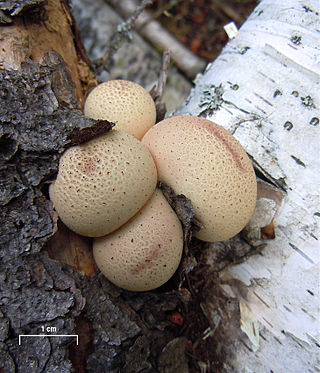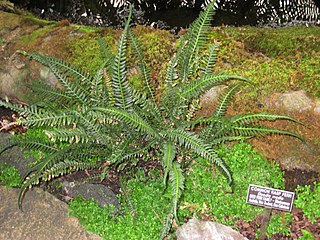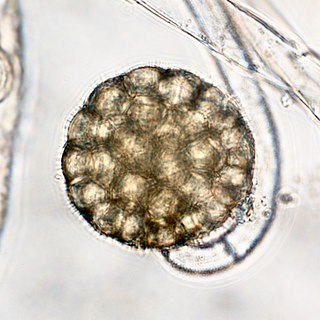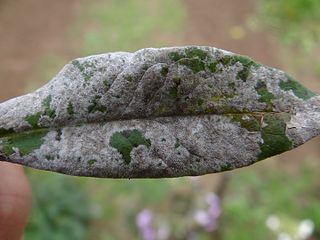| Pilaira | |
|---|---|
 | |
| Pilaira anomala | |
| Scientific classification | |
| Domain: | Eukaryota |
| Kingdom: | Fungi |
| Division: | Mucoromycota |
| Order: | Mucorales |
| Family: | Pilobolaceae |
| Genus: | Pilaira Teigh. |
| Species | |
See text | |
Pilaira is a genus of zygote fungi described in 1875. [1]
| Pilaira | |
|---|---|
 | |
| Pilaira anomala | |
| Scientific classification | |
| Domain: | Eukaryota |
| Kingdom: | Fungi |
| Division: | Mucoromycota |
| Order: | Mucorales |
| Family: | Pilobolaceae |
| Genus: | Pilaira Teigh. |
| Species | |
See text | |
Pilaira is a genus of zygote fungi described in 1875. [1]
The genus consists of the following species: [1]

The Orchidoideae, or the orchidoid orchids, are a subfamily of the orchid family (Orchidaceae) that contains around 3630 species. Species typically have a single (monandrous), fertile anther which is erect and basitonic.

The Myricaceae are a small family of dicotyledonous shrubs and small trees in the order Fagales. There are three genera in the family, although some botanists separate many species from Myrica into a fourth genus Morella. About 55 species are usually accepted in Myrica, one in Canacomyrica, and one in Comptonia.

Rhizopus is a genus of common saprophytic fungi on plants and specialized parasites on animals. They are found in a wide variety of organic substances, including "mature fruits and vegetables", jellies, syrups, leather, bread, peanuts, and tobacco. They are multicellular. Some Rhizopus species are opportunistic human pathogens that often cause fatal disease called mucormycosis. This widespread genus includes at least eight species.

Dasypogonaceae is a family of flowering plants based on the type genus Dasypogon, one that has traditionally not been commonly recognized by taxonomists; the plants it contains were usually included in the family Xanthorrhoeaceae. If valid, Dasypogonaceae includes four genera with 16 species. The family is endemic to Australia. The best known representative is Kingia australis.

Apioperdon pyriforme commonly known as the pear-shaped puffball or stump puffball, is a saprobic fungus present throughout much of the world. Emerging in autumn, this puffball is common and abundant on decaying logs of both deciduous and coniferous wood. It is considered a choice edible when still immature and the inner flesh is white. It is often called Lycoperdon pyriforme, but was transferred to Apioperdon in 2017 based on phylogenetic and morphological differences. It is the only species in the genus.

Posidonia is a genus of flowering plants. It contains nine species of marine plants ("seagrass"), found in the seas of the Mediterranean and around the south coast of Australia.

Pieter B. Pelser is a lecturer in Plant Systematics and the curator of the herbarium at the University of Canterbury in Christchurch, New Zealand. One research interest is the evolutionary history of the tribe Senecioneae, one of the largest tribes in the largest family of flowering plants. He wrote the most recent attempt to define and delimit this tribe and its problematic founding species Senecio. He also studies insects that eat these plants (Longitarsus) which contain pyrrolizidine alkaloids and what makes them choose which plants they eat.

Biebersteinia is a genus containing five species, of herbs in the flowering plant order Sapindales. They occur from East Mediterranean to West Siberia and Central Asia. They are normally stemless and have tuberous rhizomes.

Cunninghamella is a genus of fungi in the order Mucorales, and the family Cunninghamellaceae. The genus was circumscribed by French mycologist Alphonse Louis Paul Matruchot in Ann. Mycol. Vol.1 on page 47 in 1903.

Sawadaea is a genus of fungi in the family Erysiphaceae. The widespread genus contains nine species. One more species was added in 2011.

Doodia is a genus of ferns in the family Blechnaceae, subfamily Blechnoideae, in the suborder Aspleniineae. It is named after Samuel Doody (1656-1706), an English botanist. Distribution of the genus includes parts of Australia and New Zealand.

Doodia media, also known as rasp fern, is a fern species in the family Blechnaceae. The species was formally described by botanist Robert Brown in 1810. Distribution of the species includes New Zealand's North Island and the upper part of the South Island. It is also found in Australia and Lord Howe Island.

Pestalotiopsis is a genus of ascomycete fungi in the Sporocadaceae family.

Spirotaenia is a genus of basal unicellular green algae that may be sister to the Chlorokybophyceae. It was previously considered to be part of the Zygnemataceae. It is sexually conjugating, a mode of reproduction that was previously only known in the Zygnemataceae/Mesotaeniaceae, the sister groups to the land plants. This is surprising, as Spirotaenia is much more basal. The conjugating process is substantially aberrant. Spirotaenia may actually be more than one distinct lineage which may not be closely related.

Backusella is the sole genus of zygote fungi in the family Backusellaceae, which is classified in the order Mucorales. Members of this genus have been often isolated from plant litter, from locations around the world.

Golovinomyces is a genus of fungi in the family Erysiphaceae. It has 66 species. Many of the species cause powdery mildew. Golovinomyces was originally circumscribed in 1978 by Uwe Braun as a section of genus Erysiphe. It was promoted to distinct genus status in 1988.
Backusella dispersa is a species of zygote fungus in the order Mucorales. It was originally described in 1910 by Hagem as Mucor dispersus, but in 2020 it was combined by Andrew S. Urquhart and James K. Douch into the genus Backusella, making the new combination B. dispersa.
Backusella tarrabulga is a species of zygote fungus in the order Mucorales. It was described by Andrew S. Urquhart and James K. Douch in 2020. The specific epithet refers to the type locality; Tarra-Bulga National Park, Australia.
Calcarisporiellaceae is a family of fungi within the subkingdom Mucoromycota. It is the only family in the order Calcarisporiellales, class Calcarisporiellomycetes, subphylum Calcarisporiellomycotina and phylum Calcarisporiellomycota. It contains two known genera, Calcarisporiella and Echinochlamydosporium. The two genera each have one species.
Paecilomyces paravariotii is a species of fungus in the genus Paecilomyces in the order of Eurotiales, closely related to Paecilomyces variotii.